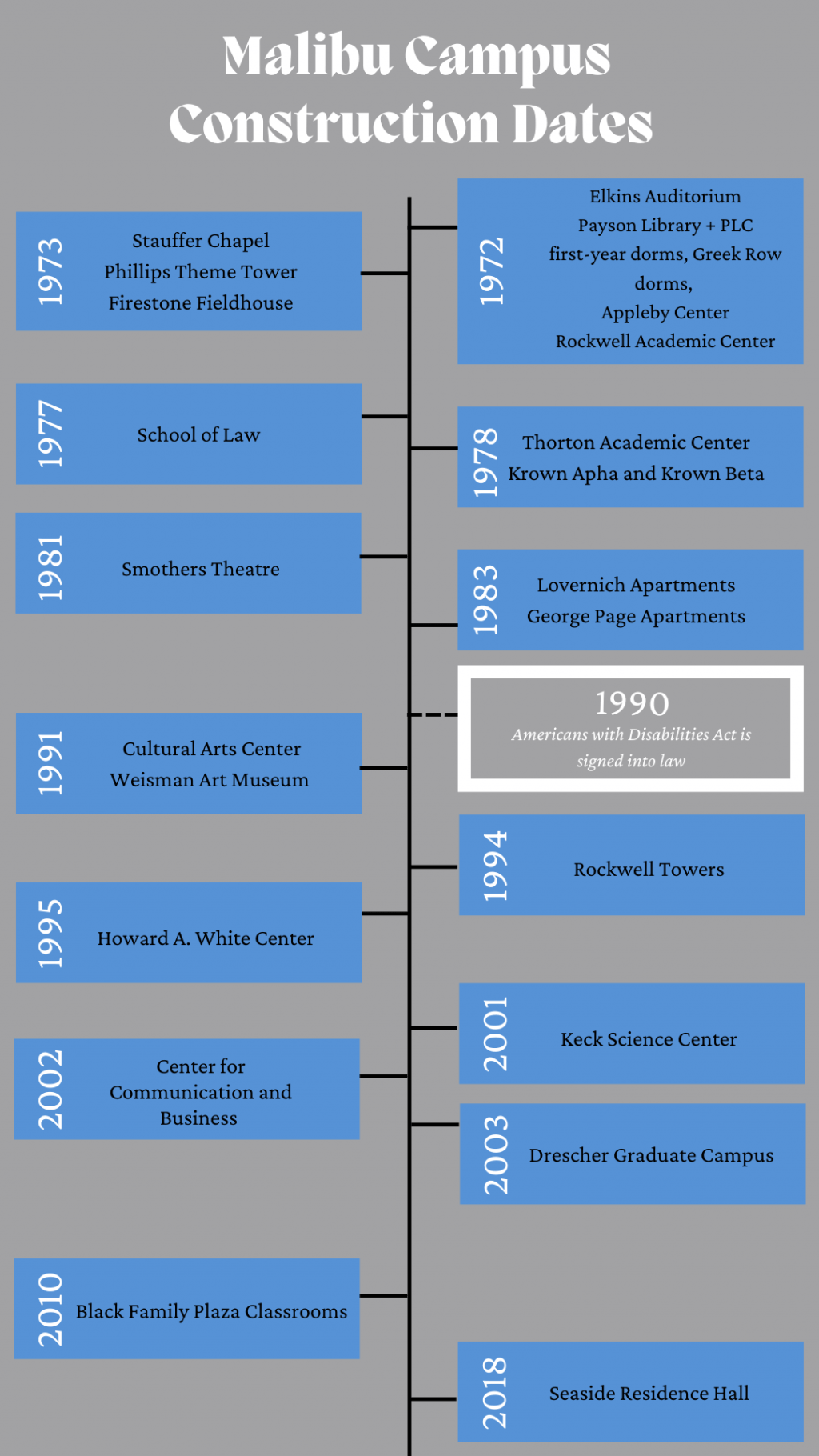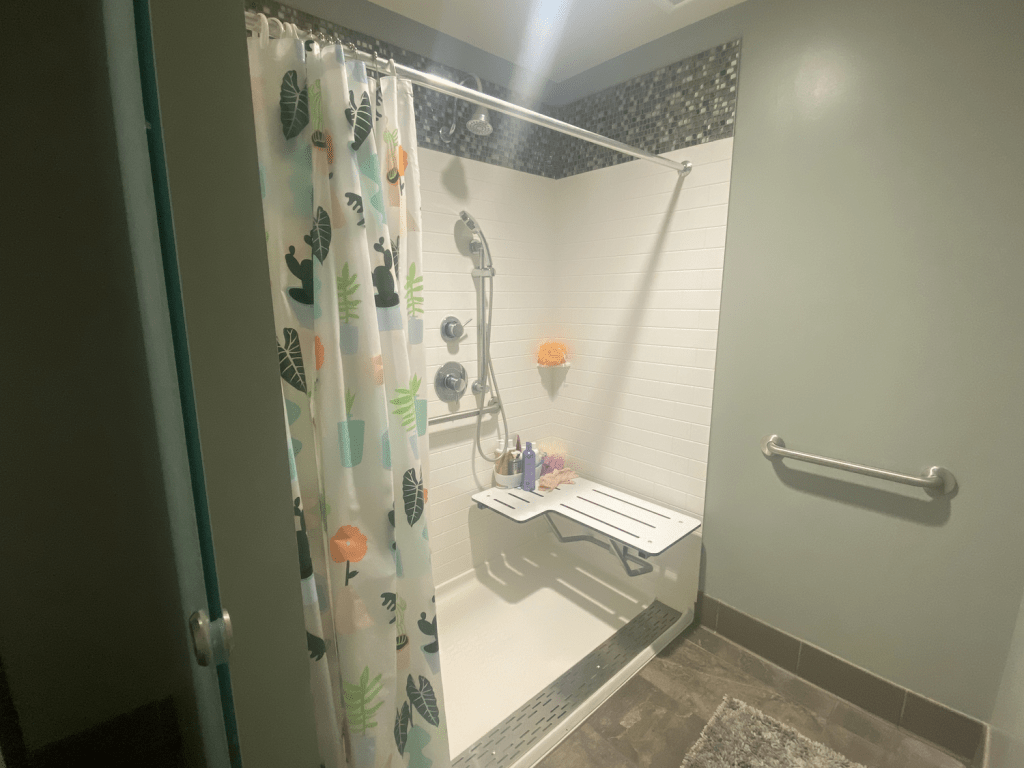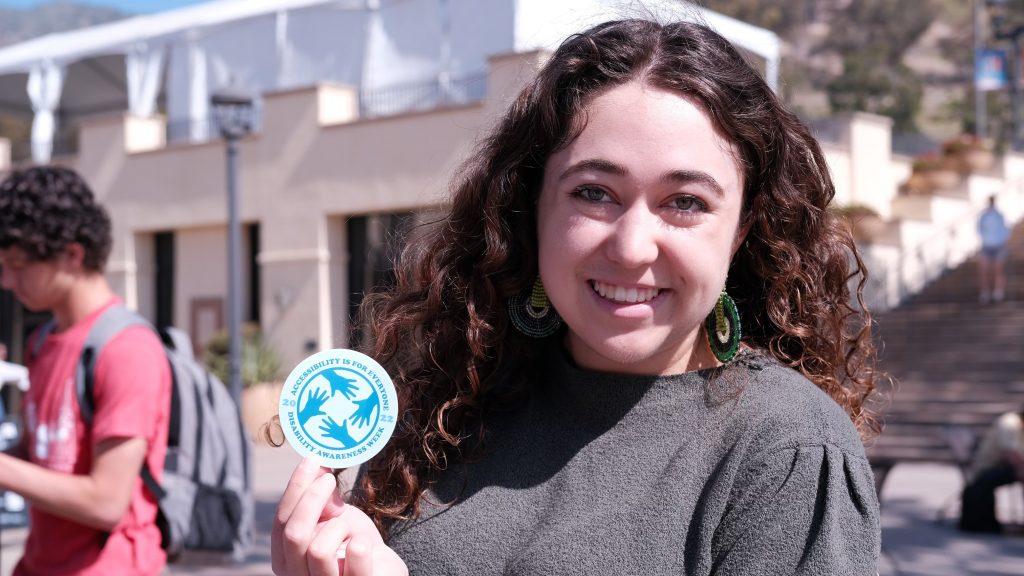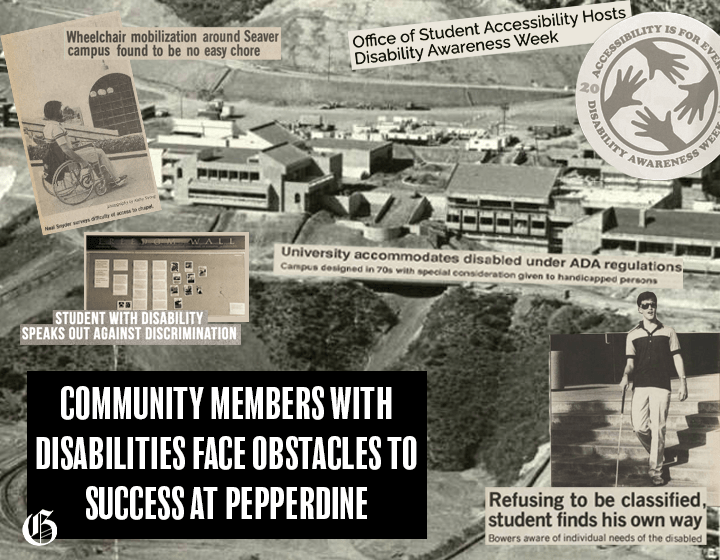
A collage of Graphic reporting regarding disability set against a photo of the Malibu campus under construction in the 1970s. Graphic by Ashley Mowreader
Norvel Young and William Banowsky first beheld the land that would be Pepperdine’s Malibu Campus on Sept. 19, 1967.
‘It was beautiful, indeed, but very rugged,” Banowsky wrote in his memoir, the Malibu Miracle. “It was dramatically apparent why it would cost extra millions to build here and why some trustees already opposed it.”
Over the next six years, the 830-acre campus rose from the mountain, creating roads, water, gas, electricity and a sewer system where there once was only dirt and rocks.
Alumna Kayla Nunn (’22) said Pepperdine’s ocean views and beautiful campus were what attracted her to the school. After sustaining an ankle injury in an intramural volleyball game in fall 2021, Nunn said she looked at campus a little differently.
“I think you walk around and you notice the amount of stairs or just different things around campus and you’re like, ‘Oh, yeah, this is inaccessible,'” Nunn said. “But that was the first time that I had to solely rely on what they would call the accessible route. It was really, really difficult.”
Nunn quickly learned the resources in place at Pepperdine may provide accommodation for her injury, but not equal access.
“For me, it was like a sense of loss of independence that was completely taken away,” Nunn said. “And I think for many with disabilities it’s a sense of trying to gain independence back or find ways to be independent in this world.”
Community members with mobility challenges shared their experiences navigating campus, advocating for change and the barriers they face at Pepperdine.
“I really do care about my education,” junior Maddie Beadle said. “But I shouldn’t have to put my health secondary to that, you know, but sometimes that’s how it feels just because of the architecture of the school.”
A History of Inaccessibility
Pepperdine’s Malibu campus construction began in 1971 with the groundbreaking event, three years prior to any federal legislation regarding accessibility.
The first piece of federal regulation came in 1973 — the year Pepperdine graduated its first class at the Malibu campus — from the Rehabilitation Act of 1973.
Section 504 of the Rehabilitation Act affects Pepperdine because the University receives federal funding, protecting disabled students and their rights to equal admissions, housing opportunities, academic offerings, financial aid and extracurriculars like athletics and social organizations.
In the 1980s, Pepperdine had an Equal Opportunity Program and 504 Coordinator who ensured students had their needs met, according to a 1986 article from the Graphic.
In 1990, President George W. Bush signed the Americans with Disabilities Act into law, further protecting individuals and their rights but most noticeably creating federal codes on building accessibility. Pepperdine, as a private institution, falls under Title III of the ADA. The Americans with Disabilities Act Amendments Act passed in 2008 and redefined the term “disability,” broadening the scope of individuals protected under the law.
Following ADA, all new construction must meet ADA codes and old architecture must remove reasonable barriers to access. While the law passed in 1990, the ADA’s standards for accessible design most directly applies to buildings built after 1992, as the planning process is subject to the federal law, not the construction.
Much of Pepperdine’s main campus construction took place between 1971 and 1973, with buildings like the Phillips Theme Tower, Stauffer Chapel, Elkins Auditorium, Payson Library, the Appleby Center, Rockwell Academic Center and Firestone Fieldhouse completed during that time. All of these buildings are exempt from Section 504 and ADA compliance codes beyond removal of barriers.

Pepperdine’s Malibu campus began construction in 1971, two years prior to any federal regulations regarding accessibility. Pepperdine’s department of Planning, Operations and Construction retroactively created access on campus and ensures all new construction follows ADA codes. Photo courtesy of the Pepperdine Library archives
Other, newer facilities should be completely up-to-date, like the construction of Seaside Residence Hall in 2018, which has several wheelchair accessible suites and accessible bathrooms, and the 2022 Enhanced Parking and Storage Project, which will add ADA spaces and accessible pathways.
Graphic by Ashley Mowreader
In a 1993 interview with the Graphic, Caruso School of Law Professor Rick Cupp explained that Pepperdine, with its 1970s construction in LA County, was not as out-of-date as older universities. Pepperdine, therefore, had fewer barriers to remove in old construction.
Cupp, in the 1993 article, said he hoped Pepperdine went beyond compliance in following ADA.
“The law has heightened our consciousness and helped us really focus on what we want to do to help people with disabilities and even how our mission as a university ties into working with people with disabilities,” Cupp said in the 1993 article.
Cupp declined requests to contribute to this article because he no longer works in disability law.
The Resources in Place
For students, Pepperdine’s accessibility and disability accommodation services primarily come through the Office of Student Accessibility. OSA Director Sandy Harrison said just over 1,000 students are registered with OSA — a number that reflects students across Pepperdine’s five schools, campuses and online students.
Around 3.5% of students registered with OSA — or around 35 — mentioned mobility issues in their intake forms, Harrison said.
OSA registration is a three-part process, Harrison said. First, students complete an intake form, then a doctor provides documentation to verify the disability and finally the student meets with OSA to create their list of accommodations.
Students have autonomy in the process, Harrison said. OSA does not prescribe any accommodations and the student must designate which classes they want to utilize their academic accommodations in.
OSA also works with the Student Care Team, the Counseling Center, Housing and Residence Life, the Department of Public Safety and faculty to accommodate students, Harrison said.
HRL can provide students with accessible housing in Seaside Residence Hall, Towers, George Page II and Drescher Apartments. There is no fully accessible residence hall for first-years, according to an April 22 email from Seth Bamburg, director of Planning, Operations and Construction.
Mobility-aid accessible dorms in Seaside have handrails in the bathrooms and wheelchair accessible entrances and showers.
Planning, Operations and Construction and HRL declined to provide the number of wheelchair accessible dorms on campus.
DPS provides mobility transportation for all students, not just those registered with OSA, Harrison said. To be eligible for DPS’s mobility transport, a person must be able to get in and out of the car without help, according to the website.
Any officer in any DPS vehicle may respond to a mobility transport call, wrote Director of Public Safety Dawn Emrich in an April 13 email to the Graphic. A student can schedule regular mobility transport or utilize the service as needed via calls to DPS.
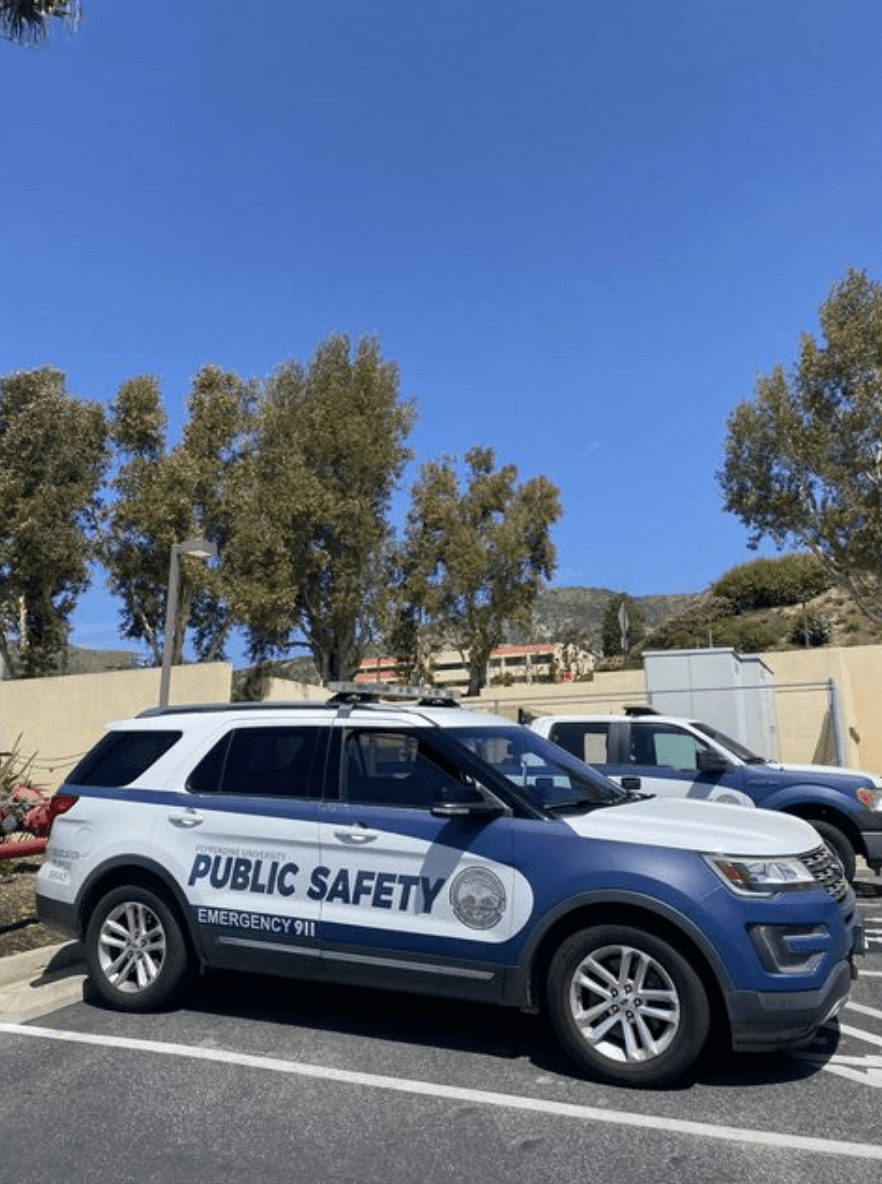
A DPS patrol car sits in front of the CCB in spring 2022. DPS provides mobility transport to students in all of its vehicles, Director of Public Safety Dawn Emrich wrote. Photo by Ashley Mowreader
Student Government Association passed Resolution #10-F21 in December to hire student mobility transport drivers, according to the SGA resolutions 2021-2022 document. The resolution also mentions purchasing a wheelchair accessible golf cart to aid in transportation. SGA indicated none of its funding would be allocated to the project.
DPS began hiring student mobility transport escorts in spring 2022, Emrich wrote. DPS and SGA’s initiatives to add drivers, as outlined in the SGA resolution and Emrich’s email, may get students to their destinations on time more frequently, as student drivers will not have other responsibilities, unlike DPS officers.
Senior Julie Lee is a student employee with DPS’s mobility transport service. Lee said she drives the patrol car and helps coordinate rides with students using the service.
Lee said she notices the difficulties getting around campus and said it’s her pleasure to help mobility-impacted students get where they need to go.
Transit Services also provides mobility transportation on a scheduled basis for those who cannot enter or exit a vehicle without help or who are wheelchair users, Transit Services Manager Sean Kavanaugh said.
Pepperdine has two wheelchair accessible shuttles — Waves 3 and Waves 5 — which can each fit two wheelchairs in the rear.
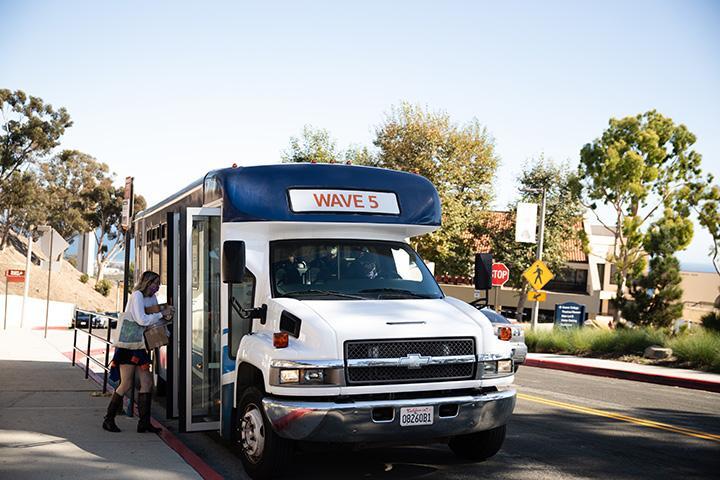
Wave 5, one of Pepperdine’s two wheelchair accessible shuttles, picks up a community member at the Seaver Main Lot stop. This stop is not wheelchair accessible, and Transit Services cannot pick up a student from this location, Transit Services Director Sean Kavanaugh said. Graphic file photo
When making arrangements for wheelchair transportation, Transit Services assigns special locations to pick up passengers, as the wheelchair lift needs to be on flat ground. Otherwise, the shuttle takes its typical routes and unloads and reloads similarly.
Kavanaugh said, in his eight years at Pepperdine, he has never seen a student utilize Transit Services for wheelchair accommodation, only guests for special events, such as Harbor.
Kavanaugh said Transit Services and shuttle drivers aim to treat everyone with dignity and respect, especially those with disabilities.
“If God loves everyone, they’re everyone,” Kavanaugh said.
The Problems
While time has changed much about Pepperdine since 1973, the architecture remains mostly the same, and with it, the problems of access.
Sophomore Emma Lake has hip dysplasia and underwent a surgery at home in December, further limiting her mobility. Lake returned to Malibu at the start of the spring 2022 semester, expecting to use a wheelchair to navigate campus while she recovered.
“I quickly found that on this campus, it’s physically impossible to be in a wheelchair,” Lake said. “It’s actually impossible.”
Lake said Pepperdine’s ramps were too steep to push herself up and doors too heavy to open from her chair. Instead, Lake used crutches, which she said delayed her recovery.
Lake also needed help getting around campus, she said. While on crutches, she couldn’t carry her backpack or her food at the Caf and she didn’t have a support system to assist her.
Beadle has a chronic illness with symptoms of fatigue, joint pain and muscle stiffness. Beadle said she first started experiencing mobility difficulties about a year and a half ago and has also faced challenges navigating campus.
Junior Maria Arguelles-Castilla also experiences mobility difficulties. Arguelles-Castilla has a service dog and recently began using a walker.
Lake, Beadle and Arguelles-Castilla all utilized DPS’ mobility transport and said they found it unreliable.
“DPS is just stretched out so thin, there’s just things that they shouldn’t be doing and mobility transportation is one of them,” Lake said.
Lake said she was constantly late to class — sometimes missing entire classes. She had trouble getting officers to pick her up at the scheduled time because they would be responding to other calls on campus or in meetings.
Arguelles-Castilla said she didn’t like the rigidity of the schedule,
“It doesn’t give you free time for like, if you want to get Starbucks after class or if you have a meeting with a professor,” Arguelles-Castilla said. “Like it just does not give you the flexibility to be able to be on campus.”
Beadle used the service less frequently than Lake and Arguelles-Castilla, only calling when she needed, but she said the long wait — an advertised 15-to-20 minute wait after calling for transport — was a deterrent.
“When I do need a temporary mobility transport, like they’re never there,” Beadle said. “It’s not super great about getting to people when they need them.”
Psychology Professor Tomas Martinez has post-polio syndrome and he’s used crutches for as long as he can remember. Martinez began teaching at Pepperdine in 1979 and said he’s had issues opening doors since the beginning.
“The concern has always been access to my classroom, access to the bathroom, getting on campus where I need to attend meetings,” Martinez said. “To some extent it’s limited my mobility in the sense that I’ve always thought about, ‘Where can I go and what can I do?'”
Martinez recently sustained injuries after falling in a bathroom on campus and is now using a wheelchair, which further restricted mobility, he said.
Parking has been an issue for Martinez, he said, but one that worsened in recent years.
“When you’re trying to get in to teach your campus classes, and there’s no place to park — I was actually getting ticketed, and had to have a discussion with the [Department of] Public Safety about the fact that I’m gonna park where I have to park,” Martinez said.
The Seaver Main Lot has 16 ADA parking spaces — 12 spanning the length of Upper Mullin Town Square between Payson Library and Smothers Theatre, two parallel parking spaces near the HAWC and two in the guest parking section.
Years ago, Martinez said he shared his parking woes with students, who elevated the issue to then-President Andrew K. Benton, who directed Emrich to help accommodate Martinez.
Emrich, Martinez said, gave him a bag of tokens to access the visitor parking to solve his problem. Martinez compared the interaction to his grandchild receiving a bag of Chuck-E-Cheese tokens from an employee to pacify him.
“Her last offer was, ‘Whenever you need a coin, just call me,’ and so I have not called her back,” Martinez said. “But I still have that bag, because I use it once in a great while when I really do need to get in.”
Instead, he arrives on campus early and stays late, because he has no other guaranteed spot in the lot.
“But that’s kind of the inconvenience of my life,” Martinez said. “But that’s at least what I’ve needed to do.”
Nunn utilized a knee-scooter for three weeks in the fall as she healed from her injury and found commuting her greatest challenge — specifically parking.
Nunn wasn’t driving due to her injury, her friends gave her rides, and she said they couldn’t find consistent parking on campus that she could access on her scooter.
She tried to work with DPS and OSA to get parking in the main Seaver lot, but wasn’t given the access she asked for. Instead, DPS offered that she utilize mobility transport, CCB parking, parking by Stauffer Chapel or for her ride to drop her off in the main lot, but not park there.
“I just had meeting after meeting with these different people and they were just telling me the same thing, but just in a very rude and just disrespectful manner where they just, like, didn’t really care to see things fixed or things changed,” Nunn said.
Nunn emailed Planning, Operations and Construction her concerns in November and the department generated a report based on her email, responding to each of her concerns with dismissal.
“In my investigation, it is evident that everyone I have spoken to cares deeply about the needs of students,” wrote Camila Bonavia, assistant vice president of Administration and Campus Operations in the report. “I am sorry that none of the options presented were satisfactory to you.”
Receiving accessible housing also proved a challenge for students.
Prior to starting school, Arguelles-Castilla applied for first-floor, accessible bathrooms and single-room accommodations through OSA for her mobility troubles and service dog. When she moved on campus in spring 2021, Arguelles-Castilla received an assignment to live on the third floor of Drescher Apartments — which lacks an elevator.
“I had everything set up to have accommodations and for the entire housing to be accessible, and it wasn’t,” Arguelles-Castilla said.
Arguelles-Castilla said she requested a room change, which HRL denied due to capacity issues.
“Like actually getting the accommodation was not a difficult process, they were super helpful making sure that, on paper, everything was met,” Arguelles-Castilla said. “My problem has just been the implementation because I have the backing, like all of it.”
For fall 2021, Arguelles-Castilla requested the same accommodations and again received third-floor housing in George Page, which also lacks an elevator. One of the students’ assigned to Arguelles-Castilla’s apartments was also allergic to dogs.
“I contacted HRL and was like, ‘Yo, like you roomed me with someone who’s allergic to my dog, I need a new placement, this is third-story, like none of this is gonna work,'” Arguelles-Castilla said. “And they messaged back saying that unless that student registered under OSA as her allergy being a disability, then they didn’t have to move her because it wasn’t a real health concern.”
Lake said she requested a room change spring 2022, after her hip surgery, because she had safety concerns in her first-year residence hall. The dorm did not have an elevator or handrails in the shower, which made her worried about falling.
HRL said it could not move Lake, but it would waive her residency requirement so she could move off-campus.
“Coming back I felt very unsafe,” Lake said. “I was terrified to shower, like it was not a good place for me and then to have Housing be like, ‘We’re not going to help you, you can move off campus, it’s not our issue anymore,’ that was kind of a punch to the face, you know, when I’m already down.”
Lake said it took the help of alumna Mackenzie Mazen (’21) to receive a new living assignment, and she moved into the Villa hotels in Drescher campus before an accessible room opened in Seaside, where she finished the spring 2022 semester.
Seaside Residence Hall suites have wheelchair accessible showers, with grab bars and a seat. Lake moved from first-year housing into Seaside following her injury. Photo by Samantha Torre
“Becoming disabled, you lose a lot of your independence and you have to depend on other people which is very, very hard,” Lake said. “When it feels as if those people who are supposed to be helping you kind of fall through, that’s very hard.”
HRL and OSA did not respond to the Graphic’s requests for comment regarding Lake and Arguelles-Castilla’s housing situations.
The Barriers of Campus
While Pepperdine is ADA compliant in its building codes and access routes, not every path is equitable.
Arguelles-Castilla, Beadle and Lake said, due to the mobility challenges they face and their disabilities, they would not choose to attend Pepperdine again.
“If I would have toured once I had the dog and once I got sick, I would not have chosen the school because [campus] is just such a big deterrent for anyone that does have disabilities,” Arguelles-Castilla said.
Beadle said Pepperdine’s student population has more students with invisible illnesses rather than permanent disabilities due to campus architecture.
“There’s a reason why we don’t see people in wheelchairs,” Beadle said. “There’s a reason why we don’t see people with different physical disabilities, because they don’t come here. Like if they thought about it, they can’t, it’s just not possible. And I don’t mean that in a limiting way, it’s like, why would you put yourself through that?”
Alumna Emily McNutt (’22) led Disability Awareness Week at Pepperdine the week of March 14 through 18 and she and other accessibility activists found places on Pepperdine’s campus that do not meet current ADA requirements, like broken door buttons, missing handrails, steep ramps and too heavy doors.
Alumna Emily McNutt (’22) poses with a promotional sticker from Disability Awareness Week at Pepperdine in March. McNutt became an advocate for accessibility after watching a parent struggle with access during New Student Orientation in fall 2021. Photo courtesy of Emily McNutt
McNutt and Nunn sent a list of accessibility issues they identified on campus to members of Pepperdine’s Planning, Operations and Construction team in November. Among their concerns of campus included a lack of resources, like Pepperdine’s interactive map not including accessible routes beyond main campus and Firestone Fieldhouse.
Even with routes that do meet compliance, Lake said she loses time taking accessible paths.
Pepperdine lists its accessible routes on its website. While the ramps and elevators may accommodate those using mobility aids like wheelchairs and scooters, most of the paths are longer than those with stairs and require several turns down winding hallways or in back entrances.
The Firestone Fieldhouse accessible route, for example, requires community members to park at the front of the building and wheel, scoot or walk around the building, past the main entrance and the ticket booth into the back door, near the pool.
Nunn mentioned the Amphitheatre as an inaccessible space on campus, as there are no ramps to get up or down the Amphitheatre directly, only a road down and around to Stauffer Chapel.
Factors of Change
When meeting with administrators, Nunn said she didn’t receive an adequate response on why the University does not implement or prioritize accessibility initiatives.
“I guess for them, it’s like a problem that they have to fix and that’s how they’re seeing it,” Arguelles-Castilla said. “Like they’re just seeing it as a burden or something they have to spend more money on, instead of making it more about the students feeling welcome.”
Pepperdine creates more accessibility on older buildings retroactively regularly as opportunities present, Bamburg wrote.
Cost and campus terrain were the two reasons administrators cited for not making changes, Nunn said.
“But I think, you are at an institution like this where you have all this money coming in from all these different avenues and these issues have been going on for so long, for multiple people, bringing them up, year after year after year after year,” Nunn said. “You would think that they would set aside money or set aside time to make these changes.”
Bamburg referenced OSA as an example of the University’s commitment to accessibility. Having disability services has been a federal requirement for universities who receive federal aid since the Rehabilitation Act 1973.
Bamburg denied cost as a factor in Planning, Operations and Construction’s changes to campus.
“The University does implement changes toward accessibility every year with every new construction project and through voluntarily providing accessibility upgrades,” Bamburg wrote. “Some examples of these voluntary upgrades are installation of push-button doors, installation of a ramping system to access multiple levels of the baseball stadium, rearranging parking spaces for proximity to accessible residences and replacing a wheelchair lift at TCC with a ramp.”
Around 15 years ago there was a student campaign for automatic push-button doors, Martinez said, which is why some bathrooms and buildings have buttons. But Martinez said he hasn’t noticed change since.
“The access that you see now is what they had 10 years ago, and not really much more accommodations,” Martinez said.
In 2017, Mazen sent an email to Seaver Dean Michael Feltner, sharing areas on campus that were hard for her to navigate on a scooter.
“Coming into Pepperdine, I knew I was going to have issues as someone who is physically incapacitated more frequently than the average student, but even from my normal illnesses it was never as difficult as it is now on the scooter,” Mazen wrote.
Most of these issues Mazen listed remain unaddressed.
“People have been trying to say this for a very long time, and it just keeps getting lost somewhere,” McNutt said. “I think there needs to be a sense of urgency that this is an issue that we allocate proper time, attention and resources to now, not later.”
The Cost of Access
Making a bathroom ADA compliant — with roll-in showers, grab bars by the toilet and in the shower and wheelchair accessible sinks — can cost between $25,000 and $40,000 and two weeks of work, according to a consultant from Call Before You Fall.
A new gas-powered rideabout golf-cart that can accommodate a power wheelchair runs about $19,000 minimum, according to quotes from James Cutajar from PHED Mobility LLC.
Pepperdine custom orders its shuttles, Kavanaugh said, with new shuttles added to the fleet every two to three years. It costs about $8,000 to add a wheelchair lift into any shuttle, and the only major consequence is reduced seating, Kavanaugh said.
To install push-buttons to activate manual doors, Juan Villanueva from Stanley Access Technologies said total cost — including equipment and installation — runs from $3,500 to $4,000.
“When you look at Pepperdine’s budget and the money they have, [$2,000] is absolutely nothing, it’s a rounding error for them,” Lake said. “For administrators to look at their disabled students and say it’s too expensive, it’s very frustrating.”
Martinez acknowledged the cost and attention of making campus accessible, but said as a Christian university, Pepperdine should strive to be open to all, not just those who are able-bodied.
Whose Job is It Anyways?
Pepperdine does not have an ADA compliance officer or an office that monitors university-wide accessibility.
Harrison said OSA reports to the Provost and is only responsible for students. Ezrah Bryant is Human Resources’ equal employment opportunity officer and provides accommodations for faculty and staff, Bryant wrote in an April 20 email to the Graphic.
Questions about ADA compliance should be referred to the Department of Design and Construction — a subsection of Planning, Operations and Construction, Bryant wrote.
The campus does not go through audits for accessibility, Bamburg wrote. DDC and POC do regular repairs, but community members who encounter problems should report issues for POC to evaluate and address.
At the time of this article, all elevators on Seaver campus had expired permits and two door buttons on main campus were not operational.
“The sad truth is how this has turned into a kind of a comedy show about disabilities where nobody’s responding and everybody says, you know, ‘Who’s on first, second, third?’ and everybody points their finger to the other person,” Martinez said. “And nobody wants to take responsibility.”
Students expressed frustration at a lack of accountability in creating access and a responsibility to self-advocate for their needs.
“I think it’s interesting because they acknowledge all these problems and things like that, but there’s just a lack of like accountability to actually like, follow through with it,” Nunn said.
Bamburg wrote the University “always” seeks to accommodate students for accessibility “to the greatest extent possible.”
Arguelles-Castilla said while working with HRL, the Student Care Team and OSA to get her accommodations, she felt they were gaslighting her or passing off the responsibility, rather than working toward solutions.
“When you’re having these issues, and when you’re having these barriers to access, you already feel like you’re inhibiting some kind of process or like you’re burdening someone with your access needs,” Arguelles-Castilla said. “So when an administration of a school that’s supposed to provide for students is also acting in the way of like, ‘It’s your fault,’ I feel like it further perpetuates the idea that the disability is the problem and not the way that it’s handled.”
McNutt said she’s met with administration about five times about accessibility and making long-term changes to campus. While some meetings — like those with NSO event organizers — went well, others with POC and DPS did not, McNutt said.
“There were other times where I did not feel super respected or like the things that I was saying were taken very seriously or it felt a little patronizing,” McNutt said.
Nunn shared similar complaints, and said she felt dismissal and disrespect from the Department of Public Safety and the Planning, Operations and Construction team.
“Dawn [Emrich] was someone who I really interacted with throughout the whole process who really, I think sparked the disrespect and like, just the utter lack of care,” Nunn said. “The way she talks — you should never talk to someone who’s trying to advocate for themselves and their needs. I don’t think you should be met with as much pushback or disregard as I was, especially from her office.”
Emrich and the Department of Public Safety did not respond directly to interviewed community members’ comments, but provided a statement to the Graphic via email.
“It is our pleasure to serve, and our department strives to meet the highest standards of professional excellence and respectful interaction,” according to DPS’ May 16 emailed statement. “On all occasions, every individual in the Department of Public Safety as a whole strives to provide services and communications promptly, professionally and respectfully.”
In its statement, DPS wrote it “fully investigates each and every complaint and concern” brought to its attention and community members not comfortable raising concerns to DPS should escalate it to University leadership.
“We are thankful we have the opportunity to, along with many other University departments, assist with a variety of items related to accessibility,” DPS wrote.
The Heart of the Educational Enterprise
Pepperdine’s Affirmation Statement affirms that “the student, as a person of infinite dignity, is the heart of the educational enterprise” and that, “the quality of student life is a valid concern of the University.”
Harrison said OSA frequently cites the Affirmation Statement in conversations about accessibility.
“Every time we meet with faculty we lead with that, ‘The student has a heart of the educational enterprise,'” Harrison said. “And that student having access is what we’re about.”
Martinez and McNutt said there are both physical and psychological barriers involved in disability and any community member with disability is forced to consider these at Pepperdine.
“There’s signs all over our campus that say, ‘You Belong Here,’ ‘You Are Loved Here,’ ‘You Matter Here,'” McNutt said. “I want those things to feel true for everyone. And I don’t think that they always do when there isn’t access.”
As a university, Beadle argued there should be more done to support students with disabilities and their academic pursuits.

Junior Maddie Beadle hands out popcorn during the “Crip Camp” screening for Disabilities Awareness Week in March 2022. Beadle experiences mobility difficulties and hopes to see change on campus in conversations about disabilities. Photo courtesy of Emily McNutt
“If we’re worried about what we can eat, how we can get to our classes, how we even can get to our dorm, then we’re not here to be educated,” Beadle said. “We’re here to just be worrying about that all the time. Like how could you expect people to succeed if they don’t have their basic needs?”
Arguelles-Castilla said she thinks part of the reason Pepperdine doesn’t make campus more accessible is the lack of students who need the resources.
Martinez echoed her sentiment, using the example of older guests or injured athletes.
“Then they provide these special accommodations, one-to-one kind of issues, but it really doesn’t really provide opportunities for anybody who lives here or wants to visit here and be a regular part of the campus here,” Martinez said.
Martinez said some students are discouraged looking at campus and the lack of accessibility, but he believes there is some access present, there just needs to be more.
“I don’t think it would have to change the entire campus,” Martinez said. “It’s really just about being more conscientious about what changes could take place to lend this community a little greater respect for who they are.”
_________________________________
Follow the Graphic on Twitter: @PeppGraphic
Contact Ashley Mowreader via Twitter (@amowreader) or by email: ashley.mowreader@pepperdine.edu

